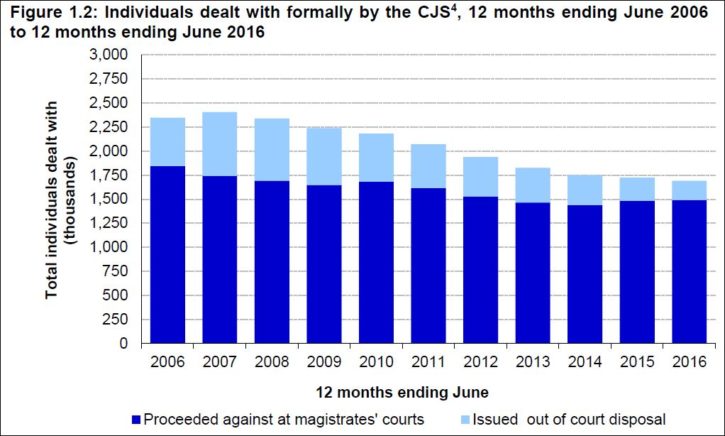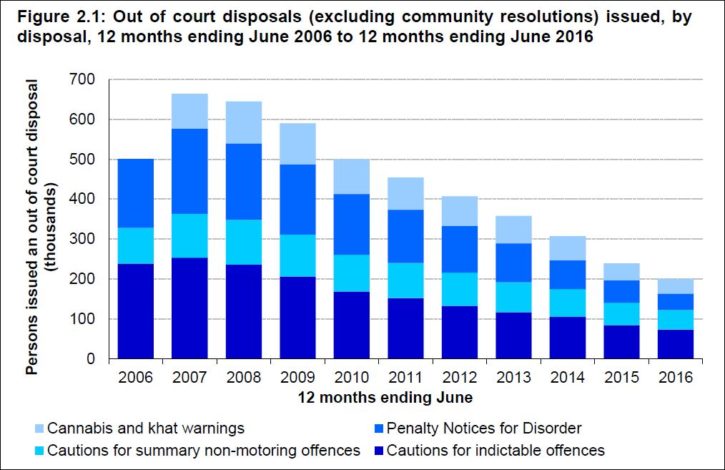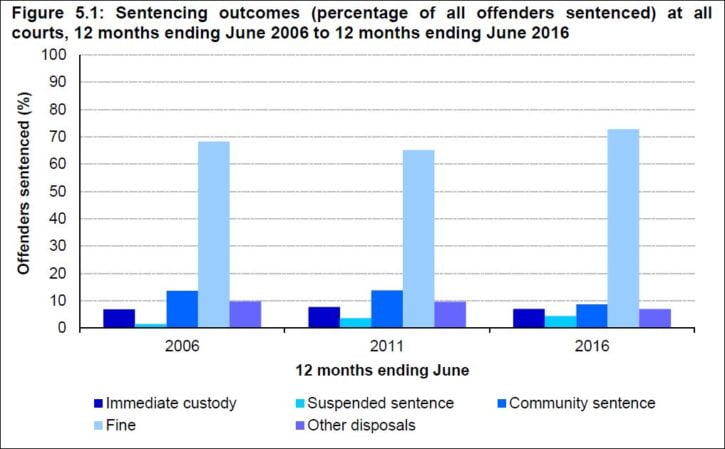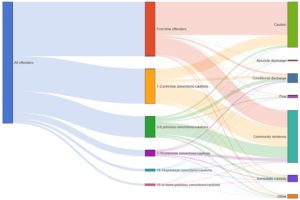Criminal justice statistics
The most recent set of criminal justice statistics (which cover the year to June 2016 and were published on 17 November 2016) neatly summarise the predicament of our justice system and just why we find it so difficult to reduce the prison population despite an unprecedented drop in crime over the last 25 years.
Fewer criminals
The total number of individuals (which includes people and companies) who have been dealt with formally by the CJS in England and Wales, has been declining since 2007, and is now at a record low level (period 1970 to June 2016), with 1.7 million individuals dealt with in the 12 months ending June 2016.

However, a greater proportion of these defendants are being dealt with by the courts; the number of out of court proposals reduced significantly. There was a drop of 26% in the use of Penalty Notices for Disorder, a fall of 15% in the number of cannabis and khat warnings and the overall cautioning rate fell by 13%.

Different pattern of offences
The total number of offenders convicted remained fairly stable last year following an increase in the previous year. In the most recent year, the total number of offenders convicted of an indictable offence reduced overall by 7%. However, the number of offenders convicted of possession of weapons, sexual offences and violence against the person increased (by 11, 9 and 6% respectively).
The number of offenders convicted of summary offences increased by 4%. This increase in defendants convicted of summary offences is relatively recent; the number was declining until the 12 months ending June 2014.
Prior to the 12 months ending June 2008, the conviction ratio had been increasing, but has since remained broadly stable, ranging from 83% in the 12 months ending June 2008 to 84% in the latest year. A similar trend has been seen in summary offences, for which the conviction ratio was also 84% in the latest year. However, the conviction ratio for indictable offences is at its highest in a decade (83%).
Sentencing
The total number of offenders sentenced at all courts has fallen since the 12 months ending June 2006, from 1.46m to 1.25m in the latest year. The number of offenders sentenced has declined over the last decade for both indictable offences (by 19%) and summary offences by 12%). In the most recent year, the number of offenders sentenced for summary offences has increased (by 4%) while the number of offenders sentenced for indictable offences has continued to decline (by 8%). The total number of offenders sentenced has remained broadly stable, increasing by 1% in the latest year.
Increase in the use of fines
The most common sentence given is a fine, accounting for 73% of offenders sentenced in the latest year. The proportion of offenders sentenced to fines has increased by 8 percentage points since the year ending June 2011. This is due to changes in offence mix and legislation; mostly an increase in the proportion of summary offences (especially speeding and TV licence evasion). Fines are much less common for indictable offences, accounting for 18% of offenders sentenced.

More and longer prison sentences
The custody rate (i.e. the proportion of sentences which are immediate custody) has remained fairly stable over the decade, between 6.7 and 8.2%. This is due to the custody rate for summary offences (which make up the majority of offences) remaining relatively low. It has been slowly falling from 2.0% in 2006 to 1.5% in 2016. Conversely, the custody rate for indictable offences has been increasing since the year ending June 2010, from 23% to 27%.
The length of prison sentences (technically known as the average custodial sentence length (ACSL)) has continued to rise. ACSL increased since the year ending June 2006, from 12.3 to 16.4 months in the latest year. The increase appears to have slowed last year, with an increase of just 1%, compared to a 6% increase between the years ending June 2014 and June 2015.
The increase over the decade is in part caused by the ACSL for sexual offences increasing by 21 months since the year ending June 2006. More people are being sentenced for sexual offences, and these sentences had been getting longer, which has driven up the overall average. In the last year, the ACSL for sexual offences did not increase, which is reflected in the slowing of the overall increase. The total number of persons sentenced for sexual offences in the latest year was 7,100, up from 4,800 in the year ending June 2006. The change could be related to improved reporting and recording of sexual offences, as well as increased public focus.
Conclusions
So there we have it. A number of different current and cross-currents:
- There are fewer people being processed by the criminal justice system as a whole, but a larger proportion of these are actually going to court — with big drops in the number of people being cautioned.
- There is a sizeable (7% since last year) drop in the number of people being convicted of more serious (indictable) crimes — but noticeable increases in sexual and violent offences.
- Finally, the proportion of people being sent to custody (now over one quarter at 27%) keeps rising as does the average length of prison sentence – now 16.4 months.
It is this last bullet point which appears to be responsible for the stubbornly high prison population — 85,897 as of last Friday 25 November 2016.
Once again, it seems that sentencing reform is key to prison reform, but we seem as far away as ever from the sort of political consensus needed to make this a reality.





